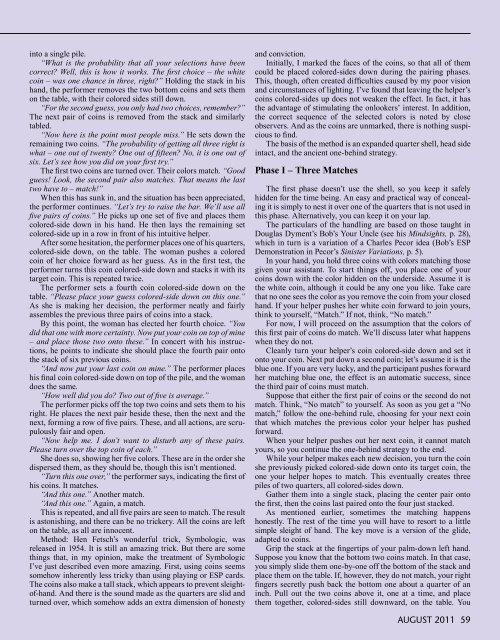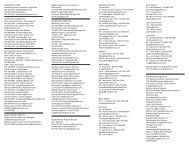(Hank) Moorehouse 1934 – 2011 - The Society of American Magicians
(Hank) Moorehouse 1934 – 2011 - The Society of American Magicians
(Hank) Moorehouse 1934 – 2011 - The Society of American Magicians
Create successful ePaper yourself
Turn your PDF publications into a flip-book with our unique Google optimized e-Paper software.
into a single pile.<br />
“What is the probability that all your selections have been<br />
correct? Well, this is how it works. <strong>The</strong> first choice <strong>–</strong> the white<br />
coin <strong>–</strong> was one chance in three, right?” Holding the stack in his<br />
hand, the performer removes the two bottom coins and sets them<br />
on the table, with their colored sides still down.<br />
“For the second guess, you only had two choices, remember?”<br />
<strong>The</strong> next pair <strong>of</strong> coins is removed from the stack and similarly<br />
tabled.<br />
“Now here is the point most people miss.” He sets down the<br />
remaining two coins. “<strong>The</strong> probability <strong>of</strong> getting all three right is<br />
what <strong>–</strong> one out <strong>of</strong> twenty? One out <strong>of</strong> fifteen? No, it is one out <strong>of</strong><br />
six. Let’s see how you did on your first try.”<br />
<strong>The</strong> first two coins are turned over. <strong>The</strong>ir colors match. “Good<br />
guess! Look, the second pair also matches. That means the last<br />
two have to <strong>–</strong> match!”<br />
When this has sunk in, and the situation has been appreciated,<br />
the performer continues. “Let’s try to raise the bar. We’ll use all<br />
five pairs <strong>of</strong> coins.” He picks up one set <strong>of</strong> five and places them<br />
colored-side down in his hand. He then lays the remaining set<br />
colored-side up in a row in front <strong>of</strong> his intuitive helper.<br />
After some hesitation, the performer places one <strong>of</strong> his quarters,<br />
colored-side down, on the table. <strong>The</strong> woman pushes a colored<br />
coin <strong>of</strong> her choice forward as her guess. As in the first test, the<br />
performer turns this coin colored-side down and stacks it with its<br />
target coin. This is repeated twice.<br />
<strong>The</strong> performer sets a fourth coin colored-side down on the<br />
table. “Please place your guess colored-side down on this one.”<br />
As she is making her decision, the performer neatly and fairly<br />
assembles the previous three pairs <strong>of</strong> coins into a stack.<br />
By this point, the woman has elected her fourth choice. “You<br />
did that one with more certainty. Now put your coin on top <strong>of</strong> mine<br />
<strong>–</strong> and place those two onto these.” In concert with his instructions,<br />
he points to indicate she should place the fourth pair onto<br />
the stack <strong>of</strong> six previous coins.<br />
“And now put your last coin on mine.” <strong>The</strong> performer places<br />
his final coin colored-side down on top <strong>of</strong> the pile, and the woman<br />
does the same.<br />
“How well did you do? Two out <strong>of</strong> five is average.”<br />
<strong>The</strong> performer picks <strong>of</strong>f the top two coins and sets them to his<br />
right. He places the next pair beside these, then the next and the<br />
next, forming a row <strong>of</strong> five pairs. <strong>The</strong>se, and all actions, are scrupulously<br />
fair and open.<br />
“Now help me. I don’t want to disturb any <strong>of</strong> these pairs.<br />
Please turn over the top coin <strong>of</strong> each.”<br />
She does so, showing her five colors. <strong>The</strong>se are in the order she<br />
dispersed them, as they should be, though this isn’t mentioned.<br />
“Turn this one over,” the performer says, indicating the first <strong>of</strong><br />
his coins. It matches.<br />
“And this one.” Another match.<br />
“And this one.” Again, a match.<br />
This is repeated, and all five pairs are seen to match. <strong>The</strong> result<br />
is astonishing, and there can be no trickery. All the coins are left<br />
on the table, as all are innocent.<br />
Method: Hen Fetsch’s wonderful trick, Symbologic, was<br />
released in 1954. It is still an amazing trick. But there are some<br />
things that, in my opinion, make the treatment <strong>of</strong> Symbologic<br />
I’ve just described even more amazing. First, using coins seems<br />
somehow inherently less tricky than using playing or ESP cards.<br />
<strong>The</strong> coins also make a tall stack, which appears to prevent sleight<strong>of</strong>-hand.<br />
And there is the sound made as the quarters are slid and<br />
turned over, which somehow adds an extra dimension <strong>of</strong> honesty<br />
and conviction.<br />
Initially, I marked the faces <strong>of</strong> the coins, so that all <strong>of</strong> them<br />
could be placed colored-sides down during the pairing phases.<br />
This, though, <strong>of</strong>ten created difficulties caused by my poor vision<br />
and circumstances <strong>of</strong> lighting. I’ve found that leaving the helper’s<br />
coins colored-sides up does not weaken the effect. In fact, it has<br />
the advantage <strong>of</strong> stimulating the onlookers’ interest. In addition,<br />
the correct sequence <strong>of</strong> the selected colors is noted by close<br />
observers. And as the coins are unmarked, there is nothing suspicious<br />
to find.<br />
<strong>The</strong> basis <strong>of</strong> the method is an expanded quarter shell, head side<br />
intact, and the ancient one-behind strategy.<br />
Phase i <strong>–</strong> three matches<br />
<strong>The</strong> first phase doesn’t use the shell, so you keep it safely<br />
hidden for the time being. An easy and practical way <strong>of</strong> concealing<br />
it is simply to nest it over one <strong>of</strong> the quarters that is not used in<br />
this phase. Alternatively, you can keep it on your lap.<br />
<strong>The</strong> particulars <strong>of</strong> the handling are based on those taught in<br />
Douglas Dyment’s Bob’s Your Uncle (see his Mindsights, p. 28),<br />
which in turn is a variation <strong>of</strong> a Charles Pecor idea (Bob’s ESP<br />
Demonstration in Pecor’s Sinister Variations, p. 5).<br />
In your hand, you hold three coins with colors matching those<br />
given your assistant. To start things <strong>of</strong>f, you place one <strong>of</strong> your<br />
coins down with the color hidden on the underside. Assume it is<br />
the white coin, although it could be any one you like. Take care<br />
that no one sees the color as you remove the coin from your closed<br />
hand. If your helper pushes her white coin forward to join yours,<br />
think to yourself, “Match.” If not, think, “No match.”<br />
For now, I will proceed on the assumption that the colors <strong>of</strong><br />
this first pair <strong>of</strong> coins do match. We’ll discuss later what happens<br />
when they do not.<br />
Cleanly turn your helper’s coin colored-side down and set it<br />
onto your coin. Next put down a second coin; let’s assume it is the<br />
blue one. If you are very lucky, and the participant pushes forward<br />
her matching blue one, the effect is an automatic success, since<br />
the third pair <strong>of</strong> coins must match.<br />
Suppose that either the first pair <strong>of</strong> coins or the second do not<br />
match. Think, “No match” to yourself. As soon as you get a “No<br />
match,” follow the one-behind rule, choosing for your next coin<br />
that which matches the previous color your helper has pushed<br />
forward.<br />
When your helper pushes out her next coin, it cannot match<br />
yours, so you continue the one-behind strategy to the end.<br />
While your helper makes each new decision, you turn the coin<br />
she previously picked colored-side down onto its target coin, the<br />
one your helper hopes to match. This eventually creates three<br />
piles <strong>of</strong> two quarters, all colored-sides down.<br />
Gather them into a single stack, placing the center pair onto<br />
the first, then the coins last paired onto the four just stacked.<br />
As mentioned earlier, sometimes the matching happens<br />
honestly. <strong>The</strong> rest <strong>of</strong> the time you will have to resort to a little<br />
simple sleight <strong>of</strong> hand. <strong>The</strong> key move is a version <strong>of</strong> the glide,<br />
adapted to coins.<br />
Grip the stack at the fingertips <strong>of</strong> your palm-down left hand.<br />
Suppose you know that the bottom two coins match. In that case,<br />
you simply slide them one-by-one <strong>of</strong>f the bottom <strong>of</strong> the stack and<br />
place them on the table. If, however, they do not match, your right<br />
fingers secretly push back the bottom one about a quarter <strong>of</strong> an<br />
inch. Pull out the two coins above it, one at a time, and place<br />
them together, colored-sides still downward, on the table. You<br />
AUGUST <strong>2011</strong> 59



